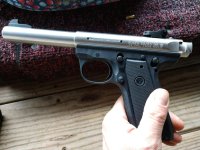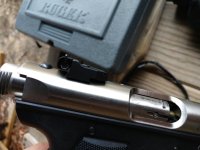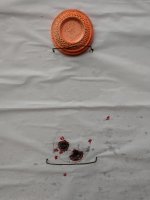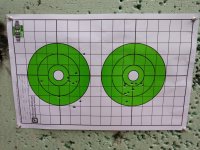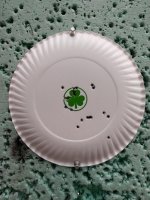I replaced the mag disconnect safety with a TandemKross hammer bushing. Now the bolt is getting slowed down by something and the bolt stop lever is very stiff unless I relieve it while holding the bolt back. The gun fires and ejects, but now needs a bump to finish the bolt returning to battery. I can't figure out what's causing the problem. Pistol still shoots accurately.
You are using an out of date browser. It may not display this or other websites correctly.
You should upgrade or use an alternative browser.
You should upgrade or use an alternative browser.
Ruger Mark III 22/45 stiff bolt and bolt stop lever
- Thread starter GarandTd
- Start date
At this point I've gone through the process several dozen times. It seems to me all parts are in where they belong. I suspect something got tweeked ever so slightly.
I did have an "oops" moment the last disassembly before installing the hammer bushing. I was having difficulty removing the barrel/receiver from the grip frame. Per manual instructions, I tapped with a rubber mallet several times before realizing that I still had a magazine in the grip frame. Once the magazine was out, the receiver came right off. It was a rubber mallet and I wasn't pounding on it like a rail spike, but that is the only thing I can think of that may have goofed something up. It's ironic since part of the reason for the modification was to eliminate the magazine from the takedown process.
I did have an "oops" moment the last disassembly before installing the hammer bushing. I was having difficulty removing the barrel/receiver from the grip frame. Per manual instructions, I tapped with a rubber mallet several times before realizing that I still had a magazine in the grip frame. Once the magazine was out, the receiver came right off. It was a rubber mallet and I wasn't pounding on it like a rail spike, but that is the only thing I can think of that may have goofed something up. It's ironic since part of the reason for the modification was to eliminate the magazine from the takedown process.
I wouldn't say I figured it out, but after many, many series of messing with the Ruger, the pistol is running proper now. I had one fail to lock-up in the 1st of 6 mags. The rest went smooth.
2 green targets: left was first mag, right was 2nd
Paper plate: 2mags (clover sticker is 1.5")
All at 25 yards from bench, Remington Thunderbolt bulk
2 green targets: left was first mag, right was 2nd
Paper plate: 2mags (clover sticker is 1.5")
All at 25 yards from bench, Remington Thunderbolt bulk
Attachments
SGW Gunsmith
Moderator
Those who you bought the hammer bushing from do not make those bushings, they just resell those that they have made by someone else.
Quality Control is therefore NOT on the sellers menu. When a faulty part is returned, you get a replacement from the very same batch.
In the past, and they've admitted this, on another forum in a post that I have a hard copy of, that they have gotten some of these hammer bushings from the company that makes 'em, that are too friggen long and the left end of the bushing rides/drags on the inside face of the safety plate. That effect will slow down the forward motion of the bolt. Not good. Check that for yourself.
I have seen this multiple times and have replaced their hammer bushings with a "good" properly fitted, hammer bushing on a regular basis. Consider this. Ruger uses manufacturing tolerances. What that means when replacing hammer bushings, is, "one size does not fit all".
The bushings I use are fit to each specific hammer bushing hole diameter and the "over-all length" is closely held, and often adjusted, so it doesn't drag on the safety plate.
Quality Control is therefore NOT on the sellers menu. When a faulty part is returned, you get a replacement from the very same batch.
In the past, and they've admitted this, on another forum in a post that I have a hard copy of, that they have gotten some of these hammer bushings from the company that makes 'em, that are too friggen long and the left end of the bushing rides/drags on the inside face of the safety plate. That effect will slow down the forward motion of the bolt. Not good. Check that for yourself.
I have seen this multiple times and have replaced their hammer bushings with a "good" properly fitted, hammer bushing on a regular basis. Consider this. Ruger uses manufacturing tolerances. What that means when replacing hammer bushings, is, "one size does not fit all".
The bushings I use are fit to each specific hammer bushing hole diameter and the "over-all length" is closely held, and often adjusted, so it doesn't drag on the safety plate.
SGW Gunsmith
Moderator
Yes, you should see some bluing wear, or if stainless, there will be rub marks from that end of the bushing.
UPDATE: I thought I had gotten this Ruger 22/45 running properly with the TK hammer bushing, but I was wrong. It's been plagued with several jams per magazine for quite a while now. I finally decided the benefits offered by the bushing were not worth the problems it created. I returned the Ruger to stock form and it is now functioning smoothly without the jamming. Relatively inexpensive lesson learned.
This Ruger is a target pistol/plinker/range toy for me. Although I'm not a big fan of the mag disconnect, for this pistol and it's uses, it doesn't bother me to have it reinstalled. Whatever differences the bushing made in the trigger pull were trivial. And, having torn this thing apart and put it back together so many times, the Xtra steps required for cleaning don't even phase me now. I think the one thing I'll miss the most is going to be the mags dropping free, but not that big of a deal. I'm glad to have it operating smoothly again and because of that, I expect to take it out more often.
This Ruger is a target pistol/plinker/range toy for me. Although I'm not a big fan of the mag disconnect, for this pistol and it's uses, it doesn't bother me to have it reinstalled. Whatever differences the bushing made in the trigger pull were trivial. And, having torn this thing apart and put it back together so many times, the Xtra steps required for cleaning don't even phase me now. I think the one thing I'll miss the most is going to be the mags dropping free, but not that big of a deal. I'm glad to have it operating smoothly again and because of that, I expect to take it out more often.
Blindstitch
New member
Good to hear it's working again. I picked up a Mark 4 hunter in October and can't wait to get it back to the range. I've been shooting cci minimags but cycle thunderbolts in the mix and haven't noticed any difference.
The 1st time I let the bolt slam shut after restoring the gun to stock I could tell the problem was solved. The problems were definately not ammo specific. And so far, this pistol has not showed signs of being picky. Not picky as far as operating, accuracy varies from one brand to the next. It shoots 40gr CCI blazer exceptionally well and Thunderbolts impressively too. Armscor is ok. I have some federal and some 38gr CCI Blazer that I haven't tried in it yet. I'm confident the Blazer will perform. Time will tell on the Federal.
Try the CCI or Federal standard velocity 40-grain RN loads. You can even try CCI Green Tag which is intended for pistol, but which is reduced velocity to let guns get back on target faster during rapid fire. Overall, I've found the CCI and Federal standard velocity loads to do best in my Ruger pistols. The only thing that ever showed signs of grouping tighter for me were some CCI hollow points, but they would produce about one flier in every 8 shots, neutralizing the advantage to the rounds that grouped better. If I had ever figured out how to sort the bad ones out, I'd have had a new 50-yard load to use.
SGW Gunsmith
Moderator
The replacement hammer bushings intention was to replace the magazine disconnect, only. They don't have anything to do with trigger pull weight reduction. Sear angle work or a replacement sear will get that done for you.UPDATE: I thought I had gotten this Ruger 22/45 running properly with the TK hammer bushing, but I was wrong. It's been plagued with several jams per magazine for quite a while now. I finally decided the benefits offered by the bushing were not worth the problems it created. I returned the Ruger to stock form and it is now functioning smoothly without the jamming. Relatively inexpensive lesson learned.
This Ruger is a target pistol/plinker/range toy for me. Although I'm not a big fan of the mag disconnect, for this pistol and it's uses, it doesn't bother me to have it reinstalled. Whatever differences the bushing made in the trigger pull were trivial. And, having torn this thing apart and put it back together so many times, the Xtra steps required for cleaning don't even phase me now. I think the one thing I'll miss the most is going to be the mags dropping free, but not that big of a deal. I'm glad to have it operating smoothly again and because of that, I expect to take it out more often.
How tightly did that replacement bushing fit into the hammer bushing hole? Was it tight or sloppy? Most all I've found involving that brand were quite loose and able to drift side to side.
When I installed my bushing then pistol jammed almost ever round.
I tried everything.
Upgraded extractors, recoil springs, removed the loaded chamber indicator.
Removing the bushing was the fix.
It was a huge waste of time and effort except that I now know the 22/45 inside and out.
I tried everything.
Upgraded extractors, recoil springs, removed the loaded chamber indicator.
Removing the bushing was the fix.
It was a huge waste of time and effort except that I now know the 22/45 inside and out.
ammo.crafter
New member
Upgrading
If you are inclined to upgrade you Ruger, I suggest Volquartsen as a good source for quality products.
If you are inclined to upgrade you Ruger, I suggest Volquartsen as a good source for quality products.

